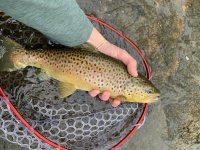Andrwhite610
Well-known member
I’ve recently been fishing the Tulpehocken very frequently in the mornings. I’m very new to fly fishing so have no experience targeting rising fish. I’ve been having success on nymphs and a few eats on my stimulator that I use mostly as an indicator for dry dropper. I often see many fish rising and especially this morning. The flat I was fishing was going off with fish some definitely trout. They were leaping out of the water and sometimes twice at what I guess was their target. I did not notice any obvious insects in the air or on the water. I did see some very, very tiny flies on the surface. Unfortunately did not get a photo. Is this what they are after? I knew I didn’t have anything similar or small enough in my box to try to match what I saw. I didn’t get too frustrated and continued focus on the nymph fishing. Maybe someone familiar with the Tully can clue me in. Thanks for reading!









